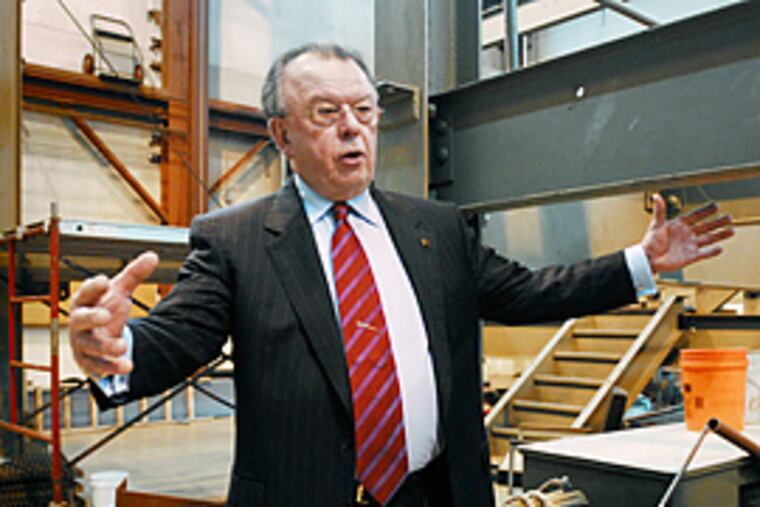How one trade union forged 20% diversity
Ironworkers' high participation rate.

When Joe Dougherty joined the Ironworkers Local 401 four decades ago, the Philadelphia union's idea of diversity was bringing in an Italian ironworker from South Philly.
How vanilla was it?
Not only was this union nearly 100 percent white, but it was nearly 100 percent Irish, too - and not just any Irish either. Most members were descendants of immigrants from Newfoundland.
Now, the 804-member still-primarily-Irish local is one of the most diverse of the Philadelphia building trades. Now, 96 of the members are black and 19 Hispanic. Overall, nearly one in five members is from a minority group, according to data given to City Council.
How did it change?
It's an important question because the building trades are under pressure from City Council to boost minority participation if they want city construction projects to remain union. A dispute on minority participation nearly derailed the $700 million expansion of the Convention Center.
For Local 401, increasing minority participation took a federal lawsuit, an American Indian chief from the Onondaga tribe in New York, and Dougherty's willingness to say no to fathers and uncles who wanted to bring sons and nephews into the union.
"Our problem wasn't discrimination," Dougherty said. "It was nepotism."
In 1982, when Dougherty was elected to the union's top job, the union had just signed a consent decree to increase minority participation.
A federal lawsuit had been filed by minorities alleging discrimination. To settle the suit, the ironworkers agreed to raise their numbers under the supervision of U.S. District Judge Clifford Scott Green, an African American, now deceased.
At the time, the union, which was drawing most of its members from the then-Irish neighborhoods of Brewerytown and Fairmount, was about 5 percent minority. "So obviously something was wrong," Dougherty said.
Anthony Wigglesworth remembers part of what Dougherty did. At the time, Wigglesworth was a city employee monitoring minority participation in building projects.
Now, his nonprofit organization, the Philadelphia Area Labor Management Committee, has been acting as an intermediary between City Council and the building trades over minority participation.
Dougherty was including American Indians as minorities, Wigglesworth said. And, at first, Wigglesworth wasn't buying it.
"I thought it was a subterfuge," Wigglesworth said. "It turns out there are a tremendous amount of American Indians in ironworking."
Since the 1920s, Indians have been well-represented among ironworkers because of their reputation for sure-footedness and fearlessness on the steel framework of skyscrapers.
The Indians tended to travel around the country as union employees of the big steel companies, and when they came into Philadelphia on projects, they would join the local ironworkers' union, Dougherty said.
Dougherty persuaded some to relocate, enlisting as an ally a union ironworker who happened to be the chief of an Onondaga tribe from New York state.
"He wanted to help his other Indians from the reservations - the young people coming up the ladder," Dougherty said. Now, Local 401 includes 36 American Indians.
Even though Indians had been doing such work around the country for decades, Wigglesworth said, they helped break a psychological barrier in Philadelphia by showing that nonwhites could handle the work - joining the first steel beams together, often at great heights, among the most difficult and dangerous in the trade.
"There's a certain hierarchy of skill in unions. A good joiner is respected among his peers," Wigglesworth said. "It takes a lot of intestinal fortitude; that's the euphemism I always use, because it's in the same area."
To draw minority candidates, Dougherty relied on simple advertising - billboards on the highways, display ads in neighborhood newspapers, and street signs at busy intersections in minority neighborhoods. He also developed relationships with the public schools.
"I don't see where minorities can't make it through our program," he said. "Some don't, of course, but then some white kids don't either. Some people have a fear of heights. If you have a fear of heights, you are going to take yourself out."
Applicants started by taking a test. Those who passed were put to work immediately. If they impressed the foremen and supervisors, they would be admitted to the apprentice program, when there was enough work to build an apprentice class.
The best got in - the rest had to wait, even if they were sons and brothers.
He said that he managed to increase minority numbers in the apprenticeship programs, but that it took additional nudging from the court to get contractors to the hire minority ironworkers his union produced.
The contractors told the judge that Dougherty wasn't supplying minority workers. They didn't know Dougherty kept daily records of available workers, noting whether contractors had requested minority workers. They also didn't know Dougherty had shown the records to Judge Green.
"They were caught lying," he said. "After that, I got more cooperation."
Iron Facts
Union: Ironworkers Local 401.
Headquarters: Northeast Philadelphia.
Business agent: Joseph
J. Dougherty.
President: Edward Sweeney.
Work: Assembling steel skeletons of buildings and erecting and installing fences and other steel structures.
Members: 804 journeymen and apprentices.
Demographics
City residents . . . 255
African Americans . . . 96
Hispanic Americans . . . 19
Asian Americans . . . 2
Women . . . 0
Native Americans . . . 36
SOURCE: Ironworkers Local 401 of the International Association of Bridge, Structural, Ornamental and Reinforcing Ironworkers - AFL-CIO
EndText